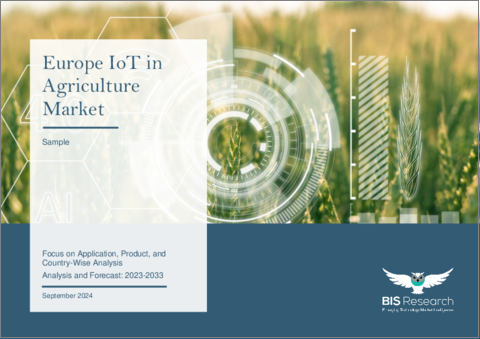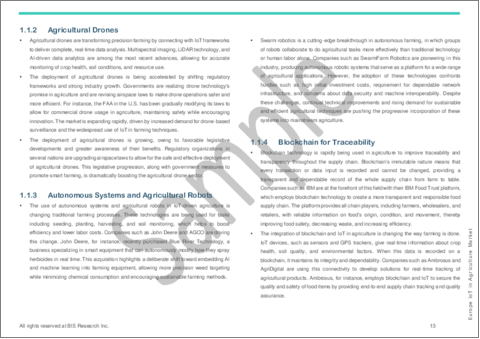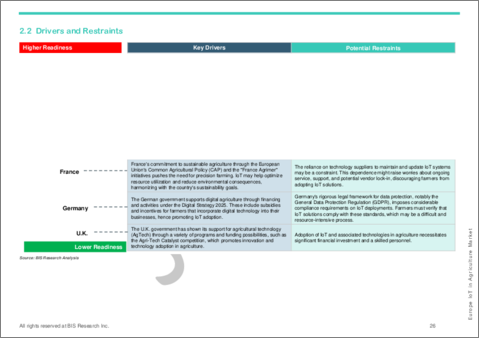|
|
市場調査レポート
商品コード
1561815
欧州の農業IoT市場:用途別、製品別、国別 - 分析と予測(2023年~2033年)Europe IoT in Agriculture Market: Focus on Application, Product, and Country-Wise Analysis - Analysis and Forecast, 2023-2033 |
||||||
カスタマイズ可能
|
|||||||
| 欧州の農業IoT市場:用途別、製品別、国別 - 分析と予測(2023年~2033年) |
|
出版日: 2024年09月27日
発行: BIS Research
ページ情報: 英文 86 Pages
納期: 1~5営業日
|
全表示
- 概要
- 図表
- 目次
欧州の農業IoTの市場規模は、2023年に51億5,000万米ドルとなりました。
同市場は、2033年には178億5,000万米ドルに達すると予測されています。モノのインターネット(IoT)は、農業プロセスの管理と最適化における大きなブレークスルーを意味するため、欧州農業におけるその重要性は強調するまでもありません。IoT技術を採用することで、農家や農業関連企業は、天候、作物の健康状態、土壌水分、その他の重要な変数を追跡するセンサーから得られるさまざまなリアルタイムデータにアクセスできるようになります。高度なアナリティクスを使用することで、このデータは精密農業をサポートするために使用され、品質と収量を向上させながら、農薬、肥料、水の散布による経費と環境への影響を低減します。
さらに、IoT技術は、植え付けから収穫までのさまざまな農業プロセスを自動化することで、人手不足を解消し、生産レベルを向上させるのに役立ちます。農業におけるIoTの統合は、よりスマートで効率的な実践を促すことで、持続可能性と効率を向上させるだけでなく、気候条件の変化や世界の食糧需要の増加に対応できる、より適応性の高い農業システムを育成することで、食糧安全保障を向上させます。
| 主要市場統計 | |
|---|---|
| 予測期間 | 2023年~2033年 |
| 2023年の評価 | 51億5,000万米ドル |
| 2033年の予測 | 178億5,000万米ドル |
| CAGR | 13.23% |
欧州の農業IoT市場は、効率性、持続可能性、生産性を向上させるために、農家や農業関連企業がますますテクノロジーを活用している結果、急速に拡大しています。モノのインターネット(IoT)とは、ネットワーク化されたセンサーやデバイスを利用してリアルタイムでデータを収集・処理し、農作業の意思決定の改善を促進するものです。
IoTソリューションは、農業生産が食糧安全保障と経済的安定の両方に不可欠な欧州では、ますます不可欠になっています。精密農業はこれらの技術によって可能になり、農家は天候パターン、作物の健康状態、土壌水分レベルを追跡できるようになります。農家は、水、肥料、農薬をより正確に散布することで、経費を削減し環境への影響を軽減しながら、作物の生産量と品質を向上させることができます。
IoT技術の採用は、欧州連合(EU)が気候変動への適応と持続可能な農業慣行を重視していることが、さらに拍車をかけています。農業における最先端技術の統合は、資源管理や労働力不足などの問題に対処するための多くの取り組みや融資プログラムによって支えられています。
当レポートでは、欧州の農業IoT市場について調査し、市場の概要とともに、用途別、製品別、国別の動向、および市場に参入する企業のプロファイルなどを提供しています。
目次
エグゼクティブサマリー
第1章 市場
- 動向:現在および将来の影響評価
- サプライチェーン分析
- 研究開発レビュー
- 規制状況
- 市場力学の概要
第2章 地域
- 地域別概要
- 促進要因と抑制要因
- 欧州
第3章 市場-競合ベンチマーキングと企業プロファイル
- 今後の見通し
- 地理的評価
- CNH Industrial N.V.
- Robert Bosch GmbH
- Heliospectra AB
- Signify Holding
- AKVA Group ASA
- AGRIVI
- Climate LLC
- Connecterra B.V.
- OSRAM GmbH
第4章 調査手法
List of Figures
- Figure 1: Europe IoT in Agriculture Market (by Application), 2022, 2026, and 2033
- Figure 2: Europe IoT in Agriculture Market (by Component), 2022, 2026, and 2033
- Figure 3: IoT in Agriculture Market, Recent Developments
- Figure 4: Supply Chain and Risks within the Supply Chain
- Figure 5: IoT in Agriculture Market (by Number of Patents), January 2020-December 2023
- Figure 6: Impact Analysis of Market Navigating Factors, 2022-2033
- Figure 7: France IoT in Agriculture Market, $Million, 2022-2033
- Figure 8: Germany IoT in Agriculture Market, $Million, 2022-2033
- Figure 9: U.K. IoT in Agriculture Market, $Million, 2022-2033
- Figure 10: Spain IoT in Agriculture Market, $Million, 2022-2033
- Figure 11: Italy IoT in Agriculture Market, $Million, 2022-2033
- Figure 12: Netherlands IoT in Agriculture Market, $Million, 2022-2033
- Figure 13: Denmark IoT in Agriculture Market, $Million, 2022-2033
- Figure 14: Rest-of-Europe IoT in Agriculture Market, $Million, 2022-2033
- Figure 15: Strategic Initiatives, 2020-2024
- Figure 16: Share of Strategic Initiatives
- Figure 17: Data Triangulation
- Figure 18: Top-Down and Bottom-Up Approach
- Figure 19: Assumptions and Limitations
List of Tables
- Table 1: Market Snapshot
- Table 2: IoT in Agriculture Market, Opportunities
- Table 3: IoT in Agriculture Market (by Region), $Million, 2022-2033
- Table 4: IoT in Agriculture Market (by Region), Thousand Unit, 2022-2033
- Table 5: Europe IoT in Agriculture Market (by Application), $Million, 2022-2033
- Table 6: Europe IoT in Agriculture Market (by Component), $Million, 2022-2033
- Table 7: Europe IoT in Agriculture Market (by Component), Thousand Unit, 2022-2033
- Table 8: France IoT in Agriculture Market (by Application), $Million, 2022-2033
- Table 9: France IoT in Agriculture Market (by Component), $Million, 2022-2033
- Table 10: France IoT in Agriculture Market (by Component), Thousand Unit, 2022-2033
- Table 11: Germany IoT in Agriculture Market (by Application), $Million, 2022-2033
- Table 12: Germany IoT in Agriculture Market (by Component), $Million, 2022-2033
- Table 13: Germany IoT in Agriculture Market (by Component), Thousand Unit, 2022-2033
- Table 14: U.K. IoT in Agriculture Market (by Application), $Million, 2022-2033
- Table 15: U.K. IoT in Agriculture Market (by Component), $Million, 2022-2033
- Table 16: U.K. IoT in Agriculture Market (by Component), Thousand Unit, 2022-2033
- Table 17: Spain IoT in Agriculture Market (by Application), $Million, 2022-2033
- Table 18: Spain IoT in Agriculture Market (by Component), $Million, 2022-2033
- Table 19: Spain IoT in Agriculture Market (by Component), Thousand Unit, 2022-2033
- Table 20: Italy IoT in Agriculture Market (by Application), $Million, 2022-2033
- Table 21: Italy IoT in Agriculture Market (by Component), $Million, 2022-2033
- Table 22: Italy IoT in Agriculture Market (by Component), Thousand Unit, 2022-203
- Table 23: Netherlands IoT in Agriculture Market (by Application), $Million, 2022-2033
- Table 24: Netherlands IoT in Agriculture Market (by Component), $Million, 2022-2033
- Table 25: Netherlands IoT in Agriculture Market (by Component), Thousand Unit, 2022-2033
- Table 26: IoT in Agriculture Market (by Application), $Million, 2022-2033
- Table 27: Italy IoT in Agriculture Market (by Component), $Million, 2022-2033
- Table 28: Italy IoT in Agriculture Market (by Component), Thousand Unit, 2022-2033
- Table 29: Rest-of-Europe IoT in Agriculture Market (by Application), $Million, 2022-2033
- Table 30: Rest-of-Europe IoT in Agriculture Market (by Component), $Million, 2022-2033
- Table 31: Rest-of-Europe IoT in Agriculture Market (by Component), Thousand Unit, 2022-2033
Introduction to Europe IoT in Agriculture Market
The Europe IoT in agriculture market was valued at $5.15 billion in 2023 and is expected to reach $17.85 billion by 2033. Internet of Things (IoT) represents a major breakthrough in the management and optimization of farming processes, therefore its importance in the European agriculture industry cannot be emphasized. Adopting IoT technologies gives farmers and agribusinesses access to a variety of real-time data from sensors tracking weather, crop health, soil moisture, and other important variables. With the use of sophisticated analytics, this data is used to support precision farming, which lowers expenses and the environmental effect of pesticide, fertilizer, and water application while increasing quality and yield.
Additionally, IoT technology helps to solve manpower shortages and increase output levels by automating a variety of agricultural processes, from planting to harvesting. By encouraging smarter, more efficient practices, the integration of IoT in agriculture not only improves sustainability and efficiency but also increases food security by fostering, more adaptive agricultural systems that can respond to changing climatic conditions and the increasing global demand for food.
| KEY MARKET STATISTICS | |
|---|---|
| Forecast Period | 2023 - 2033 |
| 2023 Evaluation | $5.15 Billion |
| 2033 Forecast | $17.85 Billion |
| CAGR | 13.23% |
Market Introduction
The agriculture IoT market in Europe is expanding quickly as a result of farmers and agribusinesses using technology more and more to improve efficiency, sustainability, and productivity. The Internet of Things, or IoT, is the use of networked sensors and devices to gather and process data in real-time, facilitating improved agricultural practice decision-making.
IoT solutions are increasingly indispensable in Europe, where agricultural production is critical to both food security and economic stability. Precision farming is made possible by these technologies, which provide farmers the ability to track weather patterns, crop health, and soil moisture levels. Farmers may improve crop output and quality while cutting expenses and lessening their impact on the environment by applying water, fertilizer, and pesticides more precisely.
The adoption of IoT technologies is further fueled by the European Union's emphasis on climate change adaption and sustainable farming practices. The integration of cutting-edge technologies in farming is supported by a number of initiatives and financing programs, which serve to address issues including resource management and labor shortages.
The desire for locally sourced and sustainable food is rising, which means that Europe's IoT for agriculture market is expected to grow significantly. The future of farming in the area is greatly influenced by IoT technology, which is developing smarter, more responsive agricultural systems.
Market Segmentation
Segmentation 1: by Application
- Precision Crop Farming
- Livestock Monitoring and Management
- Indoor Farming
- Aquaculture
- Others
Segmentation 2: by Component
- Hardware
- Processors and Sensors
- Communication Modules
- Others
- Software
Segmentation 3: by Country
- U.K.
- Germany
- France
- Spain
- Italy
- Netherlands
- Denmark
- Rest-of-Europe
How can this report add value to an organization?
Product/Innovation Strategy: The product segment helps the reader understand the different types of components available for deployment and their potential in Europe region. Moreover, the study provides the reader with a detailed understanding of the IoT in agriculture market by application on the basis of application (precision crop farming, livestock monitoring and management, indoor farming, aquaculture, and others) and product on the basis of component (hardware and software).
Growth/Marketing Strategy: The Europe IoT in agriculture market has seen major development by key players operating in the market, such as business expansion, partnership, collaboration, and joint venture. The favored strategy for the companies has been partnerships and contracts to strengthen their position in the IoT in agriculture market.
Competitive Strategy: Key players in the Europe IoT in agriculture market analyzed and profiled in the study involve major IoT in agriculture, offering companies providing IoT in agriculture for the purpose. Moreover, a detailed competitive benchmarking of the players operating in the IoT in agriculture market has been done to help the reader understand how players stack against each other, presenting a clear market landscape. Additionally, comprehensive competitive strategies such as partnerships, agreements, and collaborations will aid the reader in understanding the untapped revenue pockets in the market.
Key Market Players and Competition Synopsis
The companies that are profiled have been selected based on thorough secondary research, which includes analyzing company coverage, product portfolio, market penetration, and insights gathered from primary experts.
Some prominent names established in this market are:
- CNH Industrial N.V
- Robert Bosch GmbH
- Heliospectra AB
- Signify Holding
- AKVA Group ASA
- AGRIVI
- Climate LLC
Table of Contents
Executive Summary
Scope and Definition
1 Markets
- 1.1 Trends: Current and Future Impact Assessment
- 1.1.1 Trends: Overview
- 1.1.2 Agricultural Drones
- 1.1.3 Autonomous Systems and Agricultural Robots
- 1.1.4 Blockchain for Traceability
- 1.2 Supply Chain Analysis
- 1.2.1 Value Chain Analysis
- 1.3 Research and Development Review
- 1.3.1 Patent Filing Trend (by Country, Number of Patents)
- 1.4 Regulatory Landscape
- 1.5 Market Dynamics Overview
- 1.5.1 Market Drivers
- 1.5.1.1 Increase in Demand for Agricultural Efficiency and Productivity
- 1.5.1.2 Advancements in Agricultural Technologies
- 1.5.1.3 Rise in Adoption of Precision Farming
- 1.5.2 Market Restraints
- 1.5.2.1 Lack of Trained Personnel
- 1.5.2.2 High Initial Investment Costs
- 1.5.3 Market Opportunities
- 1.5.3.1 Integration of IoT in Robotics
- 1.5.3.2 Livestock Monitoring and Management
- 1.5.1 Market Drivers
2 Regions
- 2.1 Regional Summary
- 2.2 Drivers and Restraints
- 2.3 Europe
- 2.3.1 Regional Overview
- 2.3.2 Driving Factors for Market Growth
- 2.3.3 Factors Challenging the Market
- 2.3.4 Application
- 2.3.5 Product
- 2.3.6 France
- 2.3.7 Application
- 2.3.8 Product
- 2.3.9 Germany
- 2.3.10 Application
- 2.3.11 Product
- 2.3.12 U.K.
- 2.3.13 Application
- 2.3.14 Product
- 2.3.15 Spain
- 2.3.16 Application
- 2.3.17 Product
- 2.3.18 Italy
- 2.3.19 Application
- 2.3.20 Product
- 2.3.21 Netherlands
- 2.3.22 Application
- 2.3.23 Product
- 2.3.24 Denmark
- 2.3.25 Application
- 2.3.26 Product
- 2.3.27 Rest-of-Europe
- 2.3.28 Application
- 2.3.29 Product
3 Markets - Competitive Benchmarking & Company Profiles
- 3.1 Next Frontiers
- 3.2 Geographic Assessment
- 3.2.1 CNH Industrial N.V.
- 3.2.1.1 Overview
- 3.2.1.2 Top Products/Product Portfolio
- 3.2.1.3 Top Competitors
- 3.2.1.4 Target Customers
- 3.2.1.5 Key Personnel
- 3.2.1.6 Analyst View
- 3.2.1.7 Market Share
- 3.2.2 Robert Bosch GmbH
- 3.2.2.1 Overview
- 3.2.2.2 Top Products/Product Portfolio
- 3.2.2.3 Top Competitors
- 3.2.2.4 Target Customers
- 3.2.2.5 Key Personnel
- 3.2.2.6 Analyst View
- 3.2.2.7 Market Share
- 3.2.3 Heliospectra AB
- 3.2.3.1 Overview
- 3.2.3.2 Top Products/Product Portfolio
- 3.2.3.3 Top Competitors
- 3.2.3.4 Target Customers
- 3.2.3.5 Key Personnel
- 3.2.3.6 Analyst View
- 3.2.3.7 Market Share
- 3.2.4 Signify Holding
- 3.2.4.1 Overview
- 3.2.4.2 Top Products/Product Portfolio
- 3.2.4.3 Top Competitors
- 3.2.4.4 Target Customers
- 3.2.4.5 Key Personnel
- 3.2.4.6 Analyst View
- 3.2.4.7 Market Share
- 3.2.5 AKVA Group ASA
- 3.2.5.1 Overview
- 3.2.5.2 Top Products/Product Portfolio
- 3.2.5.3 Top Competitors
- 3.2.5.4 Target Customers
- 3.2.5.5 Key Personnel
- 3.2.5.6 Analyst View
- 3.2.5.7 Market Share
- 3.2.6 AGRIVI
- 3.2.6.1 Overview
- 3.2.6.2 Top Products/Product Portfolio
- 3.2.6.3 Top Competitors
- 3.2.6.4 Target Customers
- 3.2.6.5 Key Personnel
- 3.2.6.6 Analyst View
- 3.2.6.7 Market Share
- 3.2.7 Climate LLC
- 3.2.7.1 Overview
- 3.2.7.2 Top Products/Product Portfolio
- 3.2.7.3 Top Competitors
- 3.2.7.4 Target Customers
- 3.2.7.5 Key Personnel
- 3.2.7.6 Analyst View
- 3.2.7.7 Market Share
- 3.2.8 Connecterra B.V.
- 3.2.8.1 Overview
- 3.2.8.2 Top Products/Product Portfolio
- 3.2.8.3 Top Competitors
- 3.2.8.4 Target Customers
- 3.2.8.5 Key Personnel
- 3.2.8.6 Analyst View
- 3.2.8.7 Market Share
- 3.2.9 OSRAM GmbH
- 3.2.9.1 Overview
- 3.2.9.2 Top Products/Product Portfolio
- 3.2.9.3 Top Competitors
- 3.2.9.4 Target Customers
- 3.2.9.5 Key Personnel
- 3.2.9.6 Analyst View
- 3.2.9.7 Market Share
- 3.2.1 CNH Industrial N.V.
4 Research Methodology
- 4.1 Data Sources
- 4.1.1 Primary Data Sources
- 4.1.2 Secondary Data Sources
- 4.1.3 Data Triangulation
- 4.2 Market Estimation and Forecast





